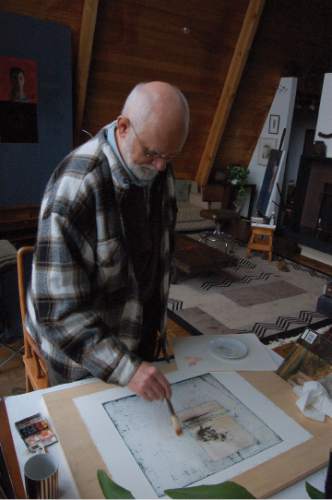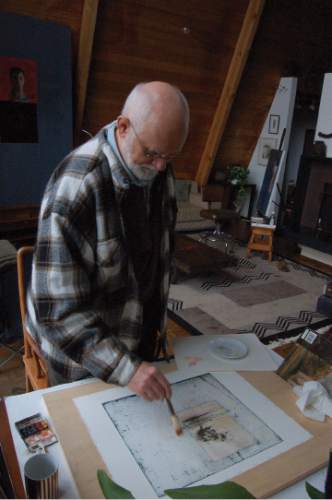This is an archived article that was published on sltrib.com in 2015, and information in the article may be outdated. It is provided only for personal research purposes and may not be reprinted.
Trevor Southey, a Utah artist who celebrated the human form and inspired a generation of students, artists and gay Mormons, died Tuesday in a Salt Lake City hospice. He was 75.
"He had a real love of the figure, of the body," said Gretchen Dietrich, executive director of the Utah Museum of Fine Arts. "He loved people, and he loved painting and drawing and sculpting people."
Utah Sen. Jim Dabakis, a longtime friend of the artist, said Southey was perhaps the first major Utah Mormon figure to come out as gay. The matter-of-fact way he did it, Dabakis said, made him an icon for the lesbian, gay, bisexual and transgender community in predominantly LDS Utah.
"When he came out, because of the supreme honesty," Dabakis said, "I think it threw off a lot of people. … He gave a lot of people the courage to say, 'If he can tell the truth, why can't we?' "
Troy Williams, executive director of Equality Utah, called Southey "a magical human being who used his art to uplift and inspire. As a gay Mormon artist, he always acknowledged human suffering and responded by bringing beauty and kindness to the world."
Southey was born in Rhodesia (now Zimbabwe) in 1940, descended from European colonists who settled in Cape Town, South Africa, in the 17th century. He converted to The Church of Jesus Christ of Latter-day Saints after hearing four missionaries singing in harmony and upon learning of the Mormon belief in the divinity of man.
After a stint in art school in Sussex, England, Southey emigrated to America, studying at Brigham Young University in Provo. He received two degrees at BYU and taught there through 1977.
His specialty was the human figure, which was considered old- fashioned in the late 20th century, Dietrich said. "He was doing figurative painting when nobody was doing figurative painting."
Southey captured much in the details of his figurative paintings. "Yes, you're looking at a painted portrait of a person," Dietrich said. "But in the other details, you're actually telling many different stories about that person: Who they are, what they value, who they love."
Southey's treatment of the human form sometimes was at odds with attitudes at LDS Church-owned BYU. He was not allowed to let his art students draw from nude models. Once Southey submitted a nude painting to a BYU faculty show, Dabakis said, and the dean persuaded him to paint over the naughty bits with latex paint — which the students quickly figured out how to peel off.
"I've always expressed my ideals as if I were living and painting in Renaissance Italy, not puritanical heartland America," Southey told The Salt Lake Tribune in 2010.
Southey's work attracted controversy in 1981, when Salt Lake City International Airport commissioned a mural. The finished work, "Flight Aspiration," depicted a nude man and woman airborne through a deep-blue sky.
"He was really proud of it, because it was awesome," his daughter Marianna Southey said. "But people were slapping luggage stickers on the offending bits."
A local anti-porn group, Citizens for True Freedom, protested the mural, saying it would incite people to rape or murder. Airport authorities ultimately took down the mural, replacing it with a smaller Southey work, an innocuous landscape. ("Flight Aspiration" is now in the permanent collection of the Utah Museum of Fine Arts.)
Dabakis met Southey when the artist came onto Dabakis' radio show to talk about the controversy. Dabakis joked that Southey was a terrible interview subject: When Dabakis asked about the anti-porn group's accusations, Southey replied, "Well, they do have a point."
"It was so much the soul of Trevor," Dabakis said. "He refused to see evil. He refused to see ugliness. He refused to look at a world that wasn't idyllic, where beauty didn't reign."
Dabakis, who owned a Park City art gallery that represented Southey, said the artist's honesty sometimes cost him business. Once, Dabakis recalled, he had nearly sold one of Southey's works to a client, until the artist started pointing out the flaws in his own work.
"I can't say how many sales we lost," Dabakis said, "because he talked a client out of a painting."
In 1982, at age 42, Southey went public that he was gay. The decision ended his marriage to Elaine. In 1985, Southey relocated to the San Francisco Bay Area and ultimately was joined there by his adult children.
Southey moved back to Provo in 2013 because of his health — he had been diagnosed with prostate cancer a decade earlier, and Parkinson's disease around 2010. His children, one by one, also moved back to Utah. For the past year, he lived in hospice in Salt Lake City.
"I like to say I've lived five lives in one body," Southey said in 2010, "and the artist's life is just one of those."
Southey is survived by his ex-wife, Elaine Fish Walton; their four children: Marianna Southey, Kevin Southey, Sarah Southey and Susanna Cornaby; and six grandchildren.
A memorial service is scheduled for Sunday, Nov. 8, at 3 p.m., in the Dumke Auditorium of the Utah Museum of Fine Arts, 410 Campus Center Drive, University of Utah, Salt Lake City.
Twitter: @moviecricket





